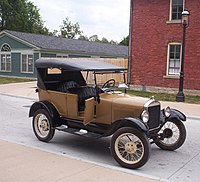
Photo from wikipedia
Abstract Ever-growing energy demand has motivated engine researchers to find eco-friendly and sustainable cleaner fuels for diesel engines. Many scientists have used different oxygenated additives to enhance the performance of… Click to show full abstract
Abstract Ever-growing energy demand has motivated engine researchers to find eco-friendly and sustainable cleaner fuels for diesel engines. Many scientists have used different oxygenated additives to enhance the performance of the acetylene fuelled diesel engine, whereas no work has been found in the literature to utilize n-butanol as an additive in acetylene dual-fuel engine. Hence, considering this important literature gap, the author has investigated the effect of n-butanol in acetylene fuelled CI engine by analysing combustion, performance and emission parameters. In the current study, an experimental investigation has been conducted on a modified diesel engine in which acetylene is being inducted at 4 LPM whereas neat diesel, B05, and B10 blend was used as a pilot fuel for different loads. The results show that when the proportion of n-butanol is increased to 10% the BTE increases by 2% than normal diesel at full load, maybe due to sufficient amount of oxygen available to combust whole acetylene-air mixture. BSEC increases marginally during acetylene induction due to the higher flame velocity of acetylene. The EGT is lower than normal diesel for entire loading conditions while running the engine on dual fuel mode. The highest value of peak cylinder pressure is 77.87 bar and the HRR is 53 J/ o CA when the B10 fuel is injected as pilot fuel. Moreover, CO value reduces by 23% than baseline diesel at maximum load whereas HC increases by 8% than normal diesel at full loading conditions. However, NO x reduces considerably i.e. 18% lower than neat diesel at peak loads, while injecting B10 blend this may be due to the higher latent heat of vaporization of n-butanol/ diesel blend causes reduced combustion temperature. The smoke opacity is lowest i.e. 44% lower than normal diesel at maximum load while injecting B10 blend in DFE. The percentage energy shared by acetylene varies from 60% to 31% for zero loads to peak load while utilizing B10 blend as pilot fuel furthermore consumption of diesel was reduced significantly by 32% at maximum load. Overall, it can be concluded that 10% of n-butanol can be blend with neat diesel for efficient utilization of acetylene in DFE.